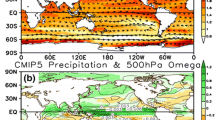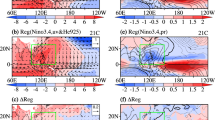Abstract
Most climate models project a weakening of theWalker circulation under global warming scenarios. It is argued, based on a global averaged moisture budget, that this weakening can be attributed to a slower rate of rainfall increase compared to that of moisture increase, which leads to a decrease in ascending motion. Through an idealized aqua-planet simulation in which a zonal wavenumber-1 SST distribution is prescribed along the equator, we find that the Walker circulation is strengthened under a uniform 2-K SST warming, even though the global mean rainfall–moisture relationship remains the same. Further diagnosis shows that the ascending branch of the Walker cell is enhanced in the upper troposphere but weakened in the lower troposphere. As a result, a “double-cell” circulation change pattern with a clockwise (anti-clockwise) circulation anomaly in the upper (lower) troposphere forms, and the upper tropospheric circulation change dominates. The mechanism for the formation of the “double cell” circulation pattern is attributed to a larger (smaller) rate of increase of diabatic heating than static stability in the upper (lower) troposphere. The result indicates that the future change of the Walker circulation cannot simply be interpreted based on a global mean moisture budget argument.
Similar content being viewed by others
References
Arakawa, A., and W. H. Schubert, 1974: Interaction of a cumulus cloud ensemble with the large-scale environment, Part I. J. Atmos. Sci., 31, 674–701.
Bayr, T., D. Dommenget, T. Martin, and S. B. Power, 2014: The eastward shift of the Walker Circulation in response to global warming and its relationship to ENSO variability. Climate Dyn., 43, 2747–2763, doi: 10.1007/s00382-014-2091-y.
Clement, A. C., R. S. Seager, M. A. Cane, and S. E. Zebiak, 1996: An ocean dynamical thermostat. J. Climate, 9, 2190–2196.
Dinezio, P., A. Clement, and G. A. Vecchi, 2010: Reconciling differing views of tropical Pacific climate change. EOS, Transactions American Geophysical Union, 91(16), 141–142.
Dinezio, P. N., A. C. Clement, G. A. Vecchi, B. Soden, B. P. Kirtman, and S.-K. Lee, 2009: Climate response of the equatorial Pacific to global warming. J. Climate, 22, 4873–4892.
Endo, H., A. Kitoh, T. Ose, R. Mizuta, and S. Kusunoki, 2012: Future changes and uncertainties in Asian precipitation simulated by multiphysics and multi-sea surface temperature ensemble experiments with high-resolution Meteorological Research Institute atmospheric general circulation models (MRI-AGCMs). J. Geophys. Res., 117, D16118.
Held, I. M., and B. J. Soden, 2006: Robust responses of the hydrological cycle to global warming. J. Climate, 19, 5686–5699.
Holton, J. R., 2004: An Introduction to Dynamic Meteorology. 4th ed., Academic Press, 535 pp.
Hsu, P.-C., and T. Li, 2012: Is “rich-get-richer” valid for Indian Ocean and Atlantic ITCZ? Geophys. Res. Lett., 39, L13705, doi: 10.1029/2012GL052399.
Huang, X. L., H. W. Chuang, A. Dessler, X. H. Chen, K. Minschwaner, Y. Ming, and V. Ramaswamy, 2013: A radiativeconvective equilibrium perspective of weakening of the tropical walker circulation in response to global warming. J. Climate, 26(5), 1643–1653.
IPCC, 2007: Climate Change 2007: The Physical Science Basis. Contribution of Working Group I to the Fourth Assessment Report of the Intergovernmental Panel on Climate Change. Solomon, S., D. Qin, M. Manning, Z. Chen, M. Marquis, K. B. Averyt, M. Tignor, H. L. Miller, Eds., Cambridge University Press, Cambridge, United Kingdom and New York, NY, USA, 996 pp.
IPCC, 2013: Climate Change 2013: The Physical Science Basis. Contribution of Working Group I to the Fifth Assessment Report of the Intergovernmental Panel on Climate Change. Stocker, T. F., and Coauthors, Eds. Cambridge University Press, Cambridge, United Kingdom and New York, NY, USA, 950 pp.
Kain, J. S., and J. M. Fritsch, 1990: A one-dimensional entraining/ detraining plume model and its application in convective parameterization. J. Atmos. Sci., 47, 2784–2802.
Kain, J. S., and J. M. Fritsch, 1993: Convective parameterization for mesoscale models: The Kain-Fritsch scheme. The Representation of Cumulus Convection in Numerical Models, Emanuel and Raymond, Eds., Amer. Meteor. Soc., 165–170.
Knutson, T. R., and S. Manabe, 1995: Time-mean response over the tropical Pacific to increased CO2 in a coupled oceanatmosphere model. J. Climate, 8, 2181–2199.
Merrifield, M. A., 2011: A shift in western Tropical Pacific Sea level trends during the 1990s. J. Climate, 24, 4126–4138.
Mizuta, R., and Coauthors, 2012: Climate simulations using the improved MRI-AGCM with 20-km grid. J. Meteor. Soc. Japan, 90A, 235–260.
Murakami, H., R. Mizuta, and E. Shindo, 2012: Future changes in tropical cyclone activity projected by multi-physics and multi-SST ensemble experiments using the 60-km-mesh MRI-AGCM. Climate Dyn., 39(9–10), 2569–2584.
Sandeep, S., F. Stordal, P. D. Sardeshmukh, and G. P. Compo, 2014: Pacific Walker Circulation variability in coupled and uncoupled climate models. Climate Dyn., 43, 103–117, doi: 10.1007/s00382-014-2135-3.
Schneider, T., P. A. O’Gorman, and X. J. Levine, 2010: Water vapor and the dynamics of climate changes. Rev. Geophys., 48, 302–323.
Shine, K. P., R. G. Derwent, D. J. Wuebbles, and J.-J. Morcrette, 1990: Radiative forcing of climate. Climate Change: The IPCC Scientific Assessment, Houghton et al., Eds. Cambridge University Press, Cambridge, United Kingdom and New York, NY, USA, 41–68.
Singh, M. S, and P. A. O’Gorman, 2012: Upward shift of the atmospheric general circulation under global warming: Theory and simulations. J. Climate, 25(23), 8259–8276.
Stocker, T. F., 2001: Climate Change 2001: The Scientific Basis. Chapter 7, J. T. Houghton, Eds., Cambridge Univ. Press, Cambridge, 417–470.
Vecchi, G. A., and B. J. Soden, 2007: Global warming and the weakening of the tropical circulation, J. Climate, 20, 4316–4340.
Vecchi, G. A., A. Clement, and B. J. Soden, 2008: Examining the tropical Pacific’s response to global warming. Eos, Transactions American Geophysical Union, 89, 81–83.
Vecchi, G. A., B. J. Soden, A. T. Wittenberg, I. M. Held, A. Leetmaa, and M. J. Harrison, 2006: Weakening of tropical Pacific atmospheric circulation due to anthropogenic forcing. Nature, 441, 73–76.
Yanai, M., S. Esbensen, and J.-H. Chu, 1973: Determination of bulk properties of tropical cloud clusters from large-scale heat and moisture budgets. J. Atmos. Sci., 30, 611–627.
Yoshimura, H., R. Mizuta, and H. Murakami, 2015: A spectral cumulus parameterization scheme interpolating between two convective updrafts with semi-Lagrangian calculation of transport by compensatory subsidence. Mon. Wea. Rev., 143, 597–621.
Yukimoto, S. H., and Coauthors, 2011: Meteorological research institute-earth system model Version 1 (MRI-ESM1)—Model description. Technical Reports of the Meteorological Research Institute, No. 64, 96 pp.
Zhang, L., and T. Li, 2014: A simple analytical model for understanding the formation of sea surface temperature patterns under global warming. J. Climate, 27, 8413–8421.
Author information
Authors and Affiliations
Corresponding author
Rights and permissions
About this article
Cite this article
Li, T., Zhang, L. & Murakami, H. Strengthening of the Walker circulation under globalwarming in an aqua-planet general circulation model simulation. Adv. Atmos. Sci. 32, 1473–1480 (2015). https://doi.org/10.1007/s00376-015-5033-7
Received:
Revised:
Accepted:
Published:
Issue Date:
DOI: https://doi.org/10.1007/s00376-015-5033-7




